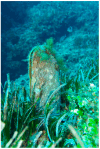Pinna nobilis, the Vanishing Giant: A Comprehensive Review on the Decline of a Mediterranean Icon
- PMID: 40723506
- PMCID: PMC12291802
- DOI: 10.3390/ani15142044
Pinna nobilis, the Vanishing Giant: A Comprehensive Review on the Decline of a Mediterranean Icon
Abstract
This review addresses the critical conservation challenges faced by Pinna nobilis, the noble pen shell, a keystone umbrella species in Mediterranean marine ecosystems. Since 2016, the species has experienced catastrophic population declines due to mass mortality events likely driven by protozoan, bacterial, and viral infections. Despite these severe circumstances, small resilient populations persist in select estuaries and coastal lagoons across the Mediterranean, offering potential for recovery. We provide a comprehensive overview on research dedicated to Pinna nobilis' biology, genetic variation, disease dynamics, and environmental factors influencing its survival, with a focus on refugia where populations still endure. Remarkably, recent studies have revealed signs of resistance in certain individuals and the potential for hybridisation with Pinna rudis. In this context, the possible impact of the increasing occurrence of hybridisation between Pinna nobilis and Pinna rudis on the conservation of their genetic diversity should be carefully considered. This review highlights the importance of ongoing conservation efforts including habitat restoration, protection of remaining populations, assessment of past and present genetic variability, and the development of captive breeding programmes. We aim to elucidate the need for continued studies on Pinna nobilis' biodiversity, particularly its evolutionary dynamics, genetic makeup, and the interplay of environmental variables influencing its survival and persistence.
Keywords: Haplosporidium pinnae; bivalve mollusc; conservation; disease; endangered species; recovery; refugia; review.
Conflict of interest statement
The authors declare no conflicts of interest.
Figures



References
-
- Garcia-March J.R. Ph.D. Thesis. Universitat de Valencia; Valencia, Spain: Apr, 2005. Aportaciones al Conocimiento de la Biología de Pinna nobilis Linneo, 1758 (Mollusca: Bivalvia) en el Litoral Mediterráneo Ibérico.
-
- Trigos S., García-March J.R., Vicente N., Tena J., Torres J. Utilization of muddy detritus as organic matter source by the fan mussel Pinna nobilis. Mediterr. Mar. Sci. 2014;15:667–674. doi: 10.12681/mms.836. - DOI
-
- Scarpa F., Sanna D., Azzena I., Cossu P., Casu M. From dark to light and back again: Is Pinna nobilis, the largest Mediterranean shellfish, on the brink of extinction? What about Pinna nobilis. Veterinaria. 2021;70:1–14.
-
- Vázquez-Luis M., Álvarez E., Barrajón A., García-March J.R., Grau A., Hendriks I.E., Jiménez S., Kersting D., Moreno D., Pérez M., et al. SOS Pinna nobilis: A mass mortality event in western Mediterranean Sea. Front. Mar. Sci. 2017;4:220. doi: 10.3389/fmars.2017.00220. - DOI
-
- Catanese G., Grau A., Valencia J.M., Garcia-March J.R., Vázquez-Luis M., Alvarez E., Deudero S., Darriba S., Carballal M.J., Villalba A. Haplosporidium pinnae sp. nov.; a haplosporidan parasite associated with mass mortalities of the fan mussel, Pinna nobilis, in the Western Mediterranean Sea. J. Invertebr. Pathol. 2018;157:9–24. doi: 10.1016/j.jip.2018.07.006. - DOI - PubMed
Publication types
Grants and funding
- LIFE PINNA LIFE20 NAT/IT/001122 CUP B95F21001880002 "Conservation and re-stocking of Pinna nobilis in the western Mediterranean and Adriatic Sea"/LIFE Program of the European Union
- Missione 4, Componente 2 "Dalla ricerca all'impresa", Investimento 1.4 Project CN00000033 which supported the National Biodiversity Future Center of the University of Sassari./Italian Ministry of University and Research, PNRR
LinkOut - more resources
Full Text Sources
Miscellaneous

